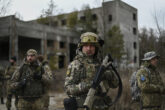November 16, 2017
All the Bombs in the World Won't Solve the North Korea Crisis (It Will Only Make It Worse)
In comments recently delivered at the Foundation for Defense of Democracies, President Donald Trump’s National Security Adviser Herbert Raymond “H.R.” McMaster reaffirmed the administration’s objective of North Korean denuclearization, repeating that a posture of “accept and deter is unacceptable.” But as North Korea continues to view the possession of a stable nuclear capability as existentially crucial to its security, negotiated North Korean denuclearization appears to remain “non-negotiable.” Instead, the administration may be considering the preventive use of force to “[deny] North Korea from threatening the United States with a weapon.” This approach may target the Kim regime, the North’s nuclear and conventional deterrence forces, or both, according to different sources. Its costs, however, significantly outweigh the purported benefits. Not only would it pose tremendous technical challenges, but the intra-alliance tensions generated by a preventive strike posture would also exacerbate the ‘decoupling’ phenomenon. Of greatest concern is that an attempt to disarm or decapitate the Kim regime could precipitate a North Korean nuclear attack—the very event such a preventive strike would seek to prevent.
Intended to prevent North Korea from acquiring an operational nuclear capability, a U.S. preventive strike would likely rely on the sudden and rapid employment of a combination of standoff munitions, cyber warfare and special forces to disorient and disarm the North Korean regime. Though policymakers might consider several options for carrying out such an attack, the notion of a more limited, high-tech preventive approach—a simultaneous effort to surgically disarm North Korea’s nascent nuclear capabilities and incapacitate its regime—may offer an apparent quick-fix to an increasingly complex challenge. Here, a decapitation strategy, either targeting North Korean leadership directly or its command and control systems, would theoretically complement a conventional disarming strike, paralyzing North Korean leadership before it can organize an effective response and without significantly committing U.S. ground forces.
Read the full op-ed in The National Interest.
More from CNAS
-
Defense / Transatlantic Security
When Defense Becomes Destruction: Austria-Hungary’s Mistake and Ukraine’s RiskThis article was originally posted on War on the Rocks. The southeastern Polish city of Przemyśl, with its elegant 19th century Habsburg-era train station, remains one of the ...
By Franz-Stefan Gady
-
Defense / Transatlantic Security
Ukraine’s Catch-22 MomentThis article was originally published in the Financial Times. In Joseph Heller’s wartime classic, Catch-22, the protagonist Yossarian seeks out the US army surgeon Doc Daneeka...
By Franz-Stefan Gady
-
CNAS Insights | Budgetary Own Goals Undermine “Speed and Volume”
On November 7, Secretary of Defense Pete Hegseth laid out a plan to overhaul the Department of Defense’s (DOD’s) acquisition system. Placing an emphasis on delivering new capa...
By Philip Sheers, Carlton Haelig & Stacie Pettyjohn
-
Drones: Who Is Making the New Weapons of War?
From Ukraine and Russia to Gaza and Sudan, drones have become a key weapon of war. Which companies are making them, and profiting from this rapidly expanding but controversial...
By Stacie Pettyjohn




